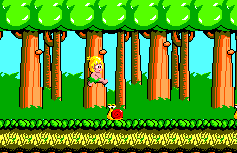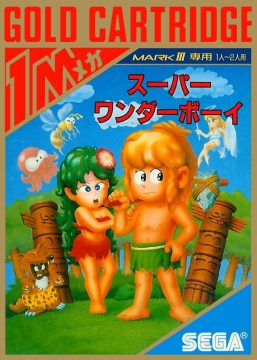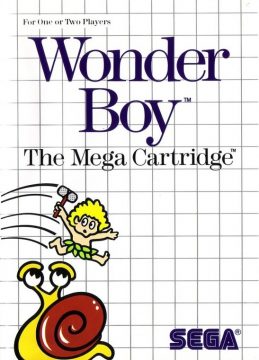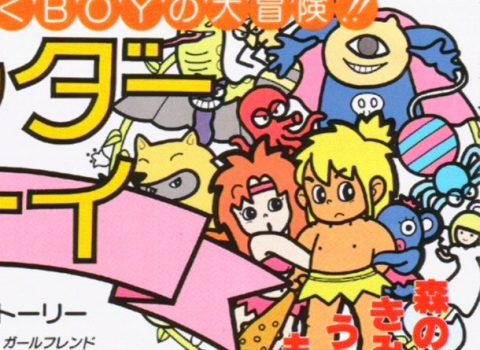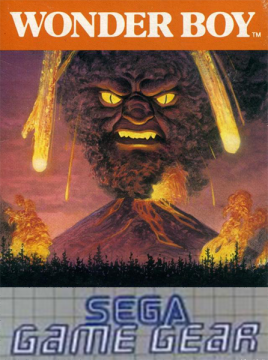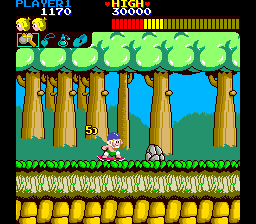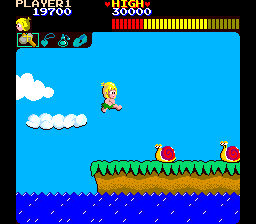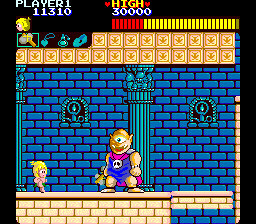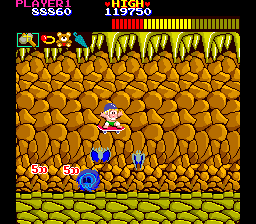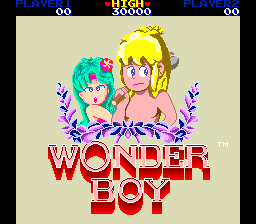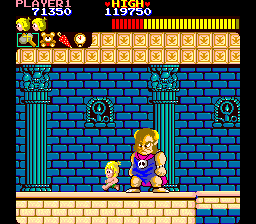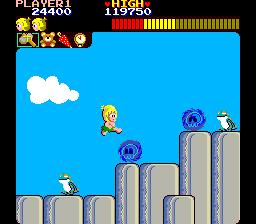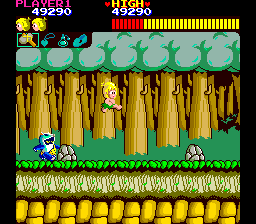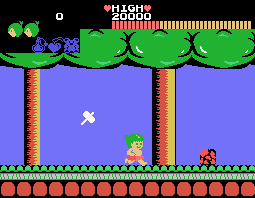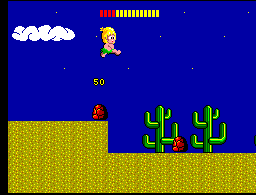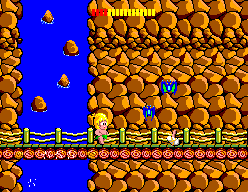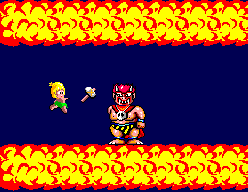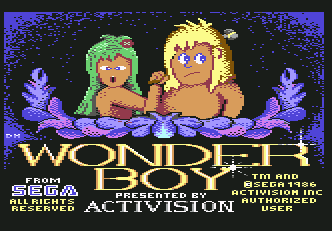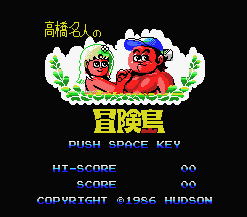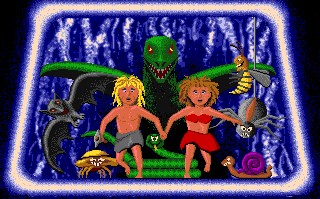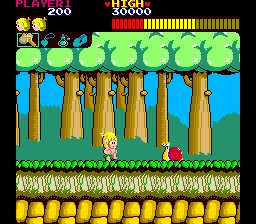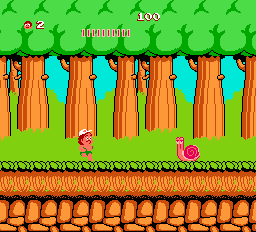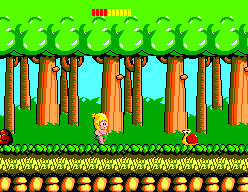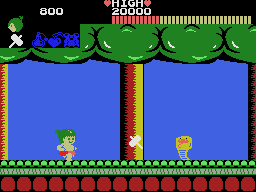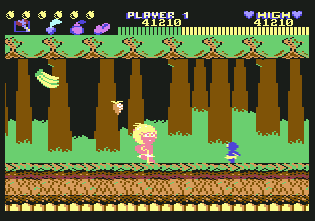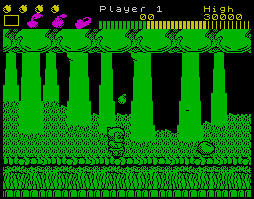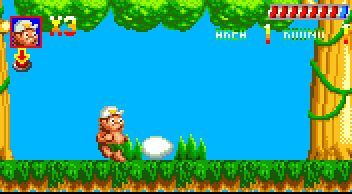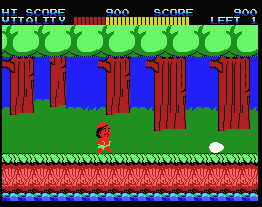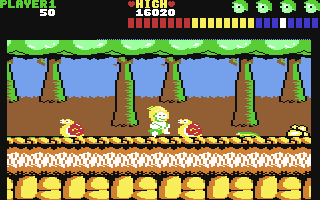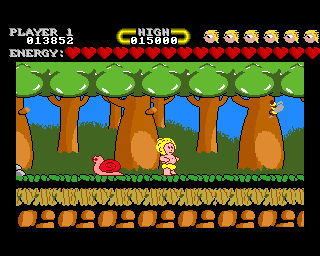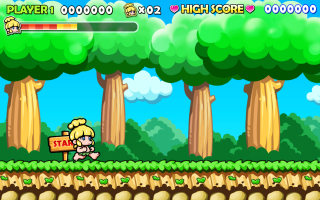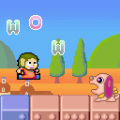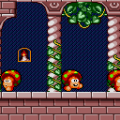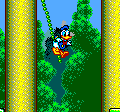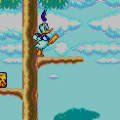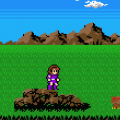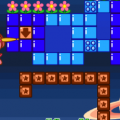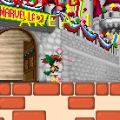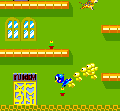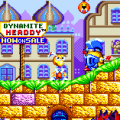Created by a development house named Escape (later renamed Westone Bit Entertainment), Wonder Boy was one of Sega’s mascot games in the mid-to-late 1980s, alongside Sega favorites like Alex Kidd. Starting off in the arcades, its history is actually one of the most complicated and baffling in all of video gaming, involving numerous spin-offs, sub-series, and licensed variations.
The first game, known simply as Wonder Boy, is a fast paced side-scrolling platformer, and was published and distributed by Sega. Hudson then obtained the rights to port Wonder Boy, but decided to replace the main character with a goofy version of Takahashi Meijin, a real-life spokesperson for the company. They rounded out his face, stuck on a baseball cap, and gave him the same grass skirt as Wonder Boy. Developed for the Famicom and NES, it was known as Takahashi Meijin no Boukenjima in Japanese, and Adventure Island in America.
For the sequel, Escape (now having changed its name to Westone), took the character of Wonder Boy and stuck him in a totally new game. Beginning a new series dubbed Monster World, it ditches the prehistoric setting of the original game for a medieval world, and introduces some light RPG elements. There are a total of four games in the Monster World series: Wonder Boy in Monster Land, Wonder Boy III: The Dragon’s Trap (known as Monster World II in Japan), Wonder Boy in Monster World (known as Wonder Boy V: Monster World III), and Monster World IV (which ditched the Wonder Boy title, since it stars a female protagonist).
Between the release of the second and third games in the Monster World series, Westone developed a unique shooter-platformer called Wonder Boy III: Monster Lair (this is unrelated to Wonder Boy III: The Dragon’s Trap, which was not released in Japan under that title). Hudson published many of these games on other platforms, but much like the Takahashi Meijin games, Hudson elected to replace Wonder Boy with different characters in each installment. Furthermore, when the Monster World games were published in Brazil, all of the characters were replaced with cast members from the Portuguese cartoon series Turma da Mônica.
Finally, Hudson took the original Wonder Boy / Takahashi Meijin / Adventure Island game and created its own separate franchise. Many of these titles were mostly similar to the first game, thereby making them more faithful to the original Wonder Boy than any of Westone’s later games. But a few of the entries, namely the fourth Famicom game and the second SNES game, cross-pollinate the series’ DNA even further by utilizing a non-linear, exploratory structure similar to Monster World.
The original Wonder Boy was initially released in the arcades, for the Sega System 2 board. As caveboy Tom-Tom (named Boy or Bocke in Japan), the goal is to rescue your green haired girlfriend Tanya (Tina in Japan) from the evil lord Drancon (“Kings” in Japan). The gameplay is patterned after the ever popular Super Mario Bros. – you run forward, jump over bad guys, and leap across moving platforms. There are seven worlds, each containing four stages, and each ending with a brief boss battle against Drancon.
The main difference to Super Mario Bros. is that Wonder Boy is even faster paced. There is a power bar at the top of the screen, but it’s not a life bar. Rather, it acts as a timer, one that counts down remarkably quickly. The only way to refill it is by grabbing the pieces of fruit that are sprinkled liberally throughout each stage. Taking a single hit will kill you, though most levels are also littered with stones. These cause you to trip and, technically, while they won’t kill you they will deplete your power meter, and can potentially send you into a bad guy or right into a pit.
While you are normally defenseless against bad guys, you can crack open eggs to grant power-ups. Hatchets are your primary weapon, and are thrown at an arc, making it good at long range but difficult to use up close. You can also find skateboards, which will let you move faster and can absorb a single hit, though its forward momentum makes it hard to control. Fairies can also grant invincibility for a limited time. There are also spotted, rotten eggs that unleash a little Grim Reaper, which drains your stamina more quickly. While the controls are slippery, the constant checkpoints ensure the game doesn’t get too frustrating. There are also wooden dolls located in each stage – if you manage to uncover all of them by the end, you unlock a hidden eighth and final world.
While Wonder Boy is a solid game, the level designs are never quite as clever as the Nintendo game it’s patterned after. And although it’s quite attractive, with lush jungle scenery, and spooky caverns made of ice or dank rock, the levels are quite repetitive. There are only about eight environments, and many levels are simply more difficult variations of previous stages. The fourth stage of each area is practically identical, right up to the boss battles, where you fight the same fireball-tossing bad guy, albeit with different faces.
The first port of Wonder Boy was for the SG-1000. This system was not built with scrolling backgrounds in mind, so the action is incredibly choppy, and the graphics are extraordinarily simplistic. Many power-ups, including the skateboard, are missing, but there is a new weapon. The levels have also been cut back and simplified. There are only five levels in total with no repeating areas, but there is brand new final stage that seems to take place in outer space. The music is also completely different. A homebrew port exists for the Mattel Colecovision.
The most well known version is the Sega Master System port, which is enhanced in a number of ways. It looks excellent, especially since the status bar has been removed, with only the vitality meter remaining at the top. The controls have been slightly messed with though. You can only do a high jump when you hold down the run button, which makes certain jumps chaotic. On the positive side, Tom-Tom is a bit less slippery and easier to keep under control.
There are two additional worlds on the SMS, making for nine in the main game, as well as the tenth hidden world for collecting all of the dolls. There are also a handful of brand new sub-stages, including a desert, a waterfall, and an area that takes place in the clouds. Along with this is a brand new boss who throws lightning rather than fireballs. It has unlimited continues, too. This version was used as the basis for a Game Gear port, which was released in North America under the name Revenge of Drancon.
In Europe, Wonder Boy was ported to several home computer platforms, courtesy of Activision. On the lower end of the ports is the ZX Spectrum version, which is stuck with green monochrome graphics, choppy scrolling and slow action. The Amstrad CPC and Commodore 64 versions are visually almost identical to each other, though the C64 version has a leg-up on speed. However, these versions only have four stages that repeat, getting slightly more difficult each time.
The NES port by Hudson, under the name Takahashi Meijin no Boukenjima in Japan and Adventure Island in America, is fairly faithful, though not nearly as graphically attractive. In North America and Europe the character’s name is changed to Master Higgins. The other character names are inconsistent depending on what you read – in some versions the female captive is named Tina, and the antagonist is King Quiller, while some advertising copy claims that you are rescuing Princess Leilani from the evil Witch Doctor.
Since Adventure Island is based on the original arcade game, it’s missing the stages added to the Master System and Game Gear releases. The dolls have been replaced with pots, and while they give bonus points, they are no longer required to reach the eighth stage, which you will always play no matter how well you do. You technically have unlimited continues, but only if you manage to find the Hudson Bee mascot in the first level. There’s also a new fireball weapon, which acts much like the hatchets but can destroy rocks and other previously invincible obstacles. The fairies are the same, but the devils are now evil flying eggplants.
The MSX port by Hudson is based off the FC/NES Adventure Island. It’s mostly the same, though while the FC/NES version has a new soundtrack, the MSX version uses the same music as the arcade game. Adventure Island was also ported to cellphones. The revised graphics are pleasant, though the bug-eyed Takahashi Meijin looks quite silly.
While Wonder Boy was not officially ported to the Amiga, there is a ripoff called Thunder Boy. It’s a poorly programmed piece of software, with bad controls and collision detection. There are a few new backgrounds, like villages and volcanoes. There is also a terrible knockoff for the Commodore 64 known as The Equalizer (AKA Toddler). While the game does not play like Wonder Boy at all – the levels are non-linear and the protagonist shoots fire – the graphics are all plagiarized (and badly redrawn) from arcade game.
Screenshot Comparisons
